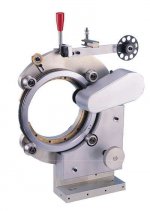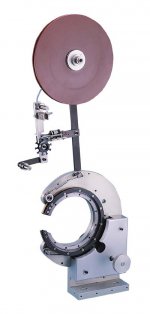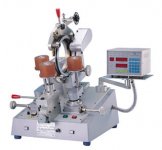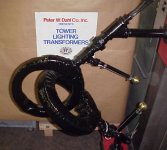Hi!
I've searched all the foruns also as google and can't find any design of a Toroidal Winding Machine.
Any help will be welcome.
Regards
Pedro Martins
I've searched all the foruns also as google and can't find any design of a Toroidal Winding Machine.
Any help will be welcome.
Regards
Pedro Martins
Thanks 'bout the link.
It's sort of that.
I'm winding using a fishing artifact, i don't know the word in engkish...
I've seen in a magazine a design of sucha a machine, but I can't find that.
I know that it's difficult, but I work well in mechanics 😉
Any more info?
Regards
Pedro Martins
It's sort of that.
I'm winding using a fishing artifact, i don't know the word in engkish...
I've seen in a magazine a design of sucha a machine, but I can't find that.
I know that it's difficult, but I work well in mechanics 😉
Any more info?
Regards
Pedro Martins
I remember an article in Elektor magazine rather a long time ago (late 80s, early 90s) on that topic. Not exactly DIY, but a brief description how toroids are made.
The only type of toroid winding machine I can think of that would be relatively easy for a DIY type to build would be a hook winder. The concept is simple - you have a compressed air driven actuator with a fairly long stroke, with a chuck on the business end. Into the chuck you insert a polished metal hook that looks rather like a knitting needle with a somewhat larger hook on the end. The hook passes through a hole in a small table, which is where you place the toroid to be wound. You start by threading the wire through the toroid so that the hook can engage it. Trigger the actuator, and the hook grabs the wire, pulls it down through the hole in the toroid, and shapes it around the toroid. You pull the rest of the wire through the toroid, bring it back around, and do it again. It sounds awkward, but once you get the hang of it, you can whip through turns pretty quickly. This type of machine is the industry standard for toroids with a relatively small number of turns using a relatively large wire gage. If you want to put 10,000 turns of #44 wire on a toroid, you'll be using a conventional (read complicated and expensive) toroid winder rather than a hook winder.
I've used hook winders to assist in winding a large toroidal 60Hz transformer by hand. I have also wound some toroids completely by hand using a crude shuttle made of printed circuit board material or a 2' long piece of 1" PVC pipe. I wind the wire supply on the shuttle or pipe, and thread it through the toroid for each turn. It's very tedious, but it works.
I've used hook winders to assist in winding a large toroidal 60Hz transformer by hand. I have also wound some toroids completely by hand using a crude shuttle made of printed circuit board material or a 2' long piece of 1" PVC pipe. I wind the wire supply on the shuttle or pipe, and thread it through the toroid for each turn. It's very tedious, but it works.
7500 USD used! And only for small toroids. I wonder how much a big machine will cost?mercator said:
About 15 years ago, I looked into buying a winder, as I was tired of being jacked around by suppliers. (Yet another reason I got tired of doing this for a living..........)
$12-15K, back then.
The trick to winding toroids is not so much the bobbin jig, but finding a way to make sure that the windings are evenly distributed along the entire core.
Jocko
$12-15K, back then.
The trick to winding toroids is not so much the bobbin jig, but finding a way to make sure that the windings are evenly distributed along the entire core.
Jocko
hi audioPT
Really cool winding machines have a shuttle (shaped like your bobbin) that goes through the toroid. They have an opening to insert the core. Then the opening is closed, the shuttle is loaded with the right length of wire. And then the toroid is wound by unloading the shuttle again.
At the lower end of the following page you will see such thingies:
http://www.weyhwang.com.tw/wh900.htm
Regards
Charles
Really cool winding machines have a shuttle (shaped like your bobbin) that goes through the toroid. They have an opening to insert the core. Then the opening is closed, the shuttle is loaded with the right length of wire. And then the toroid is wound by unloading the shuttle again.
At the lower end of the following page you will see such thingies:
http://www.weyhwang.com.tw/wh900.htm
Regards
Charles
I guess id just make a bobbin and cut it in two halves. Put it around the core and tape the bobbin to one piece again. Load the bobbin with the required amount of wire....and there you go.
Magura🙂
Magura🙂
AudioPT, the setup you show is exactly what I used to wind one transformer - the other was wound using about 2' of 1" diameter PVC pipe as the shuttle. Both worked ok, and you can place the turns as precisely as you like. It's fairly slow going, but the type of mindless activity one would do sitting in front of the TV...
Make a bobbin, that looks like a bicycle rim without spokes.
Cut it in half. Install a hinge on one end, latch on the other.
Put it through the toroid. Close and latch the bobbin.
Now, load the bobbin with enough wire for your need.
Rotate the bobbin as you wind the toroid.
If you're really good, you can make the bobbin inside out, load the wire on the inside of the diameter.
Cheers, John
Cut it in half. Install a hinge on one end, latch on the other.
Put it through the toroid. Close and latch the bobbin.
Now, load the bobbin with enough wire for your need.
Rotate the bobbin as you wind the toroid.
If you're really good, you can make the bobbin inside out, load the wire on the inside of the diameter.
Cheers, John
googel me this batman:
http://www.gormanmachine.com/900avid.html
http://www.toroid.com/standard_transformers/transformer_kits/transformer_kits.htm
And once you think your good, realy good, why not try for more HV isolation with an Astin Ring Transformer:
(its how radio stations keep the tower lights from back feading 50KW AM onto the power grid. I think it must give a touch of lightning protection too.)
http://www.gormanmachine.com/900avid.html
http://www.toroid.com/standard_transformers/transformer_kits/transformer_kits.htm
And once you think your good, realy good, why not try for more HV isolation with an Astin Ring Transformer:
(its how radio stations keep the tower lights from back feading 50KW AM onto the power grid. I think it must give a touch of lightning protection too.)
Attachments
Definitively, I'm going to put hands on work
I'll create the machine.
were to get the toroidal cores ?
what material do you plan for the machine? what kind of transformers / size so you plan to wind?
- Status
- Not open for further replies.
- Home
- Design & Build
- Parts
- DIY Toroidal Winding Machine




